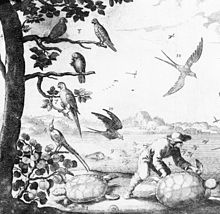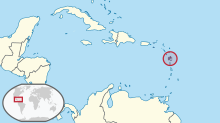| Guadeloupe amazon | |
|---|---|

| |
| Du Tertre's 1667 illustration showing three Guadeloupe amazons (8) and one Lesser Antillean macaw (7) on a tree at the left | |
| Scientific classification | |
| Domain: | Eukaryota |
| Kingdom: | Animalia |
| Phylum: | Chordata |
| Class: | Aves |
| Order: | Psittaciformes |
| Family: | Psittacidae |
| Genus: | Amazona |
| Species: | †A. violacea
|
| Binomial name | |
| †Amazona violacea (Gmelin, 1789)
| |

| |
| Location of Guadeloupe | |
| Synonyms | |
|
List
| |
The Guadeloupe amazon or Guadeloupe parrot (Amazona violacea) is a hypothetical extinct species of parrot that is thought to have been endemic to the Lesser Antillean island region of Guadeloupe. Mentioned and described by 17th- and 18th-century writers, it received a scientific name in 1789. It was moved to the genus Amazona in 1905, and is thought to have been related to, or possibly the same as, the extant imperial amazon. A tibiotarsus and an ulna bone from the island of Marie-Galante may belong to the Guadeloupe amazon. In 1905, a species of extinct violet macaw was also claimed to have lived on Guadeloupe, but in 2015, it was suggested to have been based on a description of the Guadeloupe amazon.
According to contemporary descriptions, the head, neck and underparts of the Guadeloupe amazon were mainly violet or slate, mixed with green and black; the back was brownish green; and the wings were green, yellow and red. It had iridescent feathers, and was able to raise a "ruff" of feathers around its neck. The bird fed on fruits and nuts, and the male and female took turns sitting on the nest. It was eaten by French settlers, who also destroyed its habitat. Rare by 1779, it appears to have become extinct by the end of the 18th century.
- ^ BirdLife International (2016). "Amazona violacea". IUCN Red List of Threatened Species. 2016: e.T22728701A94994037. doi:10.2305/IUCN.UK.2016-3.RLTS.T22728701A94994037.en. Retrieved 13 November 2021.
